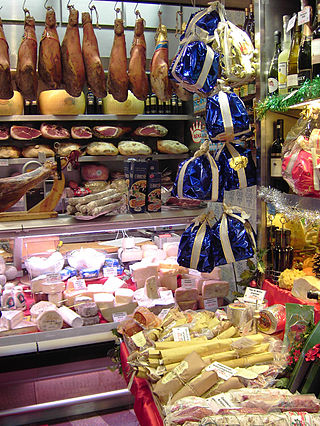
Traditionally, a delicatessen or deli is a grocery that sells a selection of fine, exotic, or foreign prepared foods. Delicatessens originated in Germany during the 18th century and spread to the United States in the mid-19th century. European immigrants to the United States, especially Ashkenazi Jews, popularized the delicatessen in U.S. culture beginning in the late 19th century. Today, many large retail stores like supermarkets have deli sections.

Pastrami is a type of cured meat originating from Romania usually made from beef brisket. Later recipes use lamb, pork, chicken or turkey. The raw meat is brined, partially dried, seasoned with herbs and spices, then smoked and steamed. Like corned beef, pastrami was originally created as a way to preserve meat before the invention of refrigeration. One of the iconic meats of Eastern European cuisine as well as American Jewish cuisine and New York City cuisine, hot pastrami is typically served at delicatessen restaurants on sandwiches such as the pastrami on rye.
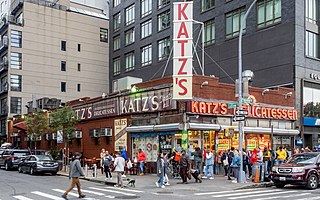
Katz's Delicatessen, also known as Katz's of New York City, is a kosher-style delicatessen at 205 East Houston Street, on the southwest corner of Houston and Ludlow Streets on the Lower East Side of Manhattan in New York City.

Schwartz's, also known as the Schwartz's Deli and the Montreal Hebrew Delicatessen, is a Jewish delicatessen restaurant and take-out, located on Saint-Laurent Boulevard in Montreal, Quebec, Canada. It was established in 1928, by Reuben Schwartz, a Jewish immigrant from Romania. Its long popularity and reputation has led to it being considered a cultural institution and landmark in Montreal.

The Second Avenue Deli is a certified-kosher Jewish delicatessen in Manhattan, New York City. It was located in the East Village until December 2007, when it relocated to 162 East 33rd Street in Murray Hill. In August 2011, it opened a second branch at 1442 First Avenue on the Upper East Side. In November 2017, it opened a cocktail lounge called 2nd Floor above its Upper East Side branch.

Kosher style refers to foods commonly associated with Jewish cuisine but which may or may not actually be kosher. It is a stylistic designation rather than one based on the laws of kashrut. In some U.S. states, the use of this term in advertising is illegal as a misleading term under consumer protection laws.
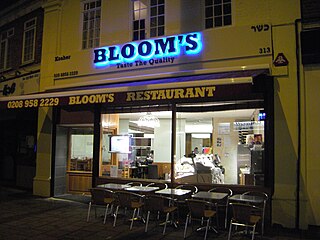
A kosher restaurant or kosher deli is an establishment that serves food that complies with Jewish dietary laws (kashrut). These businesses, which also include diners, cafés, pizzerias, fast food, and cafeterias, and are frequently in listings together with kosher bakeries, butchers, caterers, and other similar places, differ from kosher-style businesses in that they operate under rabbinical supervision, which requires the observance of the laws of kashrut, as well as certain other Jewish laws, including the separation of meat and dairy.
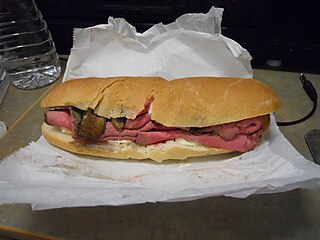
The roast beef sandwich is a sandwich that is made out of sliced roast beef or sometimes beef loaf. It is sold at many diners in the United States, as well as fast food chains, such as Arby's, Rax Roast Beef, and Roy Rogers Restaurants. This style of sandwich often comes on a hamburger bun and may be topped with barbecue sauce and/or melted American cheese. The roast beef sandwich also commonly comprises bread, cold roast beef, lettuce, tomatoes, and mustard, although it would not be uncommon to find cheese, horseradish, fresh/powdered chili pepper and even in some cases red onion. Roast beef sandwiches may be served hot or cold, and are sometimes served open faced.

Montreal-style smoked meat, Montreal smoked meat or simply smoked meat in Quebec is a type of kosher-style deli meat product made by salting and curing beef brisket with spices. The brisket is allowed to absorb the flavours over a week. It is then hot smoked to cook through, and finally is steamed to completion. This is a variation on corned beef and is similar to pastrami.

The cuisine of the Mid-Atlantic states encompasses the cuisines of the states of New York, New Jersey, Pennsylvania, Delaware, and Maryland, as well as Washington, D.C. The influences on cuisine in this region of the United States are extremely eclectic owing to the fact that it has been and continues to be a gateway for international culture as well as a gateway for new immigrants.

The Jewish-American patronage of Chinese restaurants became prominent in the 20th century, especially among Jewish New Yorkers. It has received attention as a paradoxical form of assimilation by embracing an unfamiliar cuisine that eased the consumption of non-kosher foods.

A sailor sandwich is a hot meat and cheese sandwich popular at Jewish delis in Richmond, Virginia, area restaurants. Its core ingredients are hot pastrami, grilled knackwurst, melted Swiss cheese and hot mustard on rye bread.

Pastrami on rye is a sandwich comprising sliced pastrami on rye bread, often served with mustard and Kosher dill pickles. It was popularized in the Jewish delicatessens of New York City and has been described as New York's "signature sandwich". It was created in 1888 by the Lithuanian immigrant Sussman Volk, who served it at his deli on Delancey Street in Manhattan.

American Jewish cuisine comprises the food, cooking, and dining customs associated with American Jews. It was heavily influenced by the cuisine of Jewish immigrants who came to the United States from Eastern Europe around the turn of the 20th century. It was further developed in unique ways by the immigrants and their descendants, especially in New York City and other large metropolitan areas of the northeastern U.S.
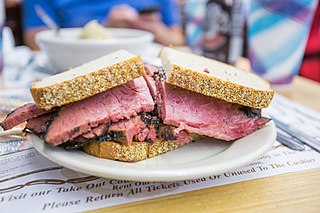
Jewish rye bread is a type of rye bread commonly made in Jewish communities. Due to the diaspora of the Jews, there are several geographical variations of the bread. The bread is sometimes called sissel bread or cissel bread, as sissel means caraway seed in Yiddish.

Texas smoked brisket or barbecue brisket, is an American dish made with brisket that is popular in Texas.

Ashkenazi Jewish cuisine is an assortment of cooking traditions that was developed by the Ashkenazi Jews of Central, Eastern, Northwestern and Northern Europe, and their descendants, particularly in the United States and other Western countries.

Attman's Delicatessen is a Jewish delicatessen in Maryland with branches in Baltimore and Potomac. The deli serves Ashkenazi staples including corned beef, pastrami, brisket, Reuben sandwiches, knishes, latkes, pickles, kugel, and whitefish salad.


















